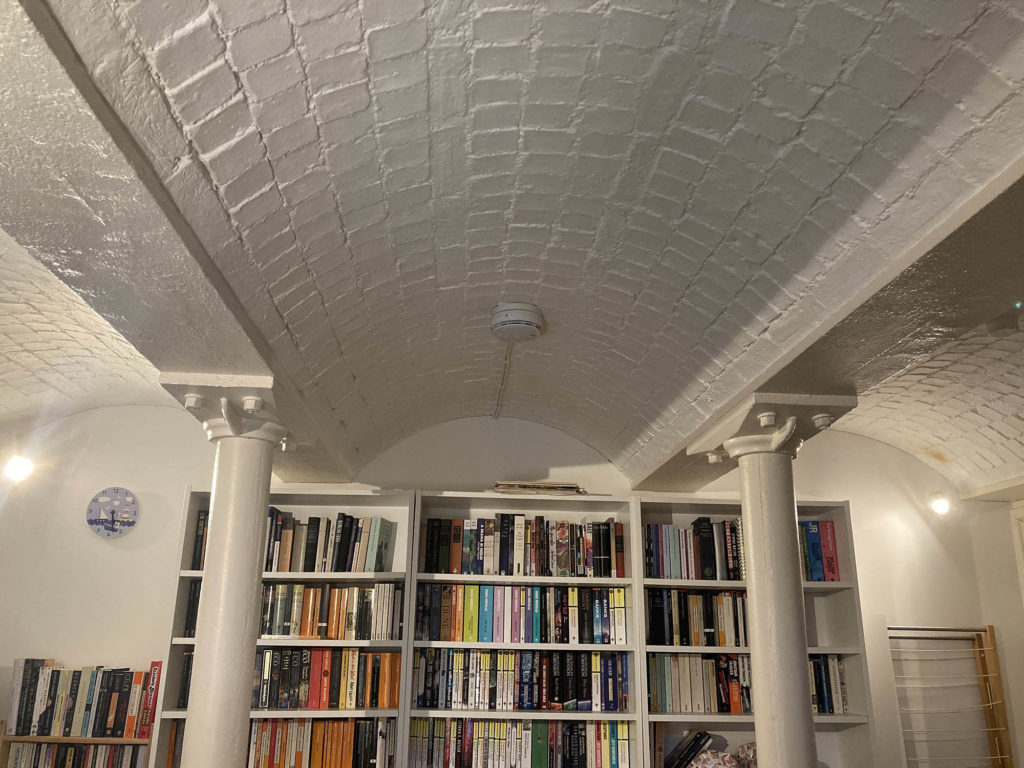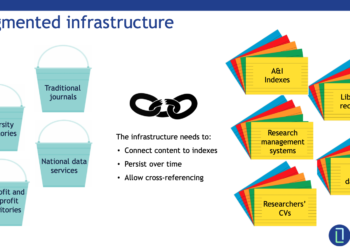Editor’s note: Today’s post is from Melissa Harrison, the Chair of JATS4R. Melissa also serves on the Board of Directors of Crossref and contributes to various working groups and taskforces via her role as Head of Production Operations at eLife.
I live in a converted barrel house, built in 1879 to store barrels of beer for the local brewery. Many people I’ve had Zoom calls with have seen and admired the funky curved ceilings of my “office”. It is not as old as the first scientific paper (Philosophical Transactions of the Royal Society, 1665), but it shares the same problematic issues when trying to update to meet the expectations of modern times.
We recently had the basement bathroom re-done — which involved infrastructure and pipework, not unlike the maintenance required for content pipelines! I was recommended a plumber who gave us a quote for the work, and we set up a date to start. He organized the job, doing the plumbing work but hiring all the other specialists needed: carpenter, tiler, electrician, and other members of his team. I never knew so many different people were needed, but I should have known.

No one expert can single-handedly overhaul a hundreds-year-old bathroom, just as no one person can produce a JATS4R recommendation to optimize the reusability of XML-based content solely on their own. Diversity of input and thought and the creative discussion is required, because different points of view are required to understand the needs. Using the recently published example of the JATS4R Peer review materials recommendation, we had publishers and indexers in the group, guest appearances from Publons, Review Commons, and the STM Peer review taxonomy group, as well as further outreach to DocMaps and the MECA working group.
Back to our bathroom, we discussed wall coverings with the tiler and decided one wall would be painted. Unbeknown to me, this would cause a gap in the wall, which meant the carpenter needed to do an unplanned patch job. This reminded me of the CRediT taxonomy. Some roles / authors just don’t fit, and without the ability to record “other”, those authors will miss out on having their contribution recorded in the machine-readable taxonomy and downstream with Crossref when it’s added to their schema. The JATS4R recommendation did what it could for publishers in this situation, but it’s still a gap in the whole process.
Just like developing standards, renovation timeframes always seem to expand! The work on the bathroom was scheduled for 2 weeks. This became 5. Anyone who has worked on a software development project or standards work will be familiar with this problem — the unknowns. When you start a project, you don’t know what you’re going to come up against and that’s all part of the fun — who wants predictability anyhow?! The tiler said the floor was too bouncy for the tiles we bought, so we had to swap to laminate tiles. New tiles had to be ordered, and the input of all the different stakeholders was rescheduled and swapped around; laying the floor was no longer the tiler’s role, but now the carpenter’s.
This is just like the newly launched JATS4R Software Citations working group. I’d like to think this will be easy because it comes after a lot of preliminary work done by Force11, as Dan Katz and Hollydawn Murry recently reported in a previous post. However, when you widen the pool of contributors and also consider things from a different perspective, there will be different considerations that may cause pause for thought.
Things are never DONE, and no solution is perfect. Without going into too much detail, plumbing in basements is not straightforward, and macerators are involved, which are problematic — I’ve just ordered warning labels for what people cannot do in this swanky, but not so flexible new bathroom. Looking at the JATS4R roadmap, 5 recommendations are listed as up for review. Taking the Authors and affiliations recommendation as an example, we can expect a growing list of things that need to be added, revised, or require further thought in our roadmap.
Despite the challenges, it’s nice to have a new bathroom — and we have a new JATS4R website too, launched last year! Although the process can be tricky at times, it’s also fun and engaging. I can say the same for chairing JATS4R. In my role, while not offering expertise in content “plumbing” (JATS), I do like community outreach and bringing together the right people to build a new recommendation. I am also a big believer in a stitch in time…saves nine. In my role at eLife I have the benefit of attending conferences and reaching out to different people about the ever-changing landscape of scholarly communication and trying to push the boundaries of what we’re doing. This arms me with extra knowledge and contacts that can benefit JATS4R.
Of course, there are limits to how flexible both a bathroom and the scholarly communication infrastructure can be. So we have to find stop-gaps and workarounds until the next change. But things do change and progress — for instance, I was pleased to get a message of thanks for our timely Preprint citation recommendation, published earlier this year. Likewise, when the Data citations recommendation was first published, we did not know that Data availability statements would become important and would have an effect on data citations. Also, I have a feeling that the aspects of data citation which initially seemed novel will no longer be so as new items of open scholarly publishing become more common: software, methods, protocols, RRIDs. The list continues to grow.
The JATS4R committee will continue to perform our outreach and pull in different expertise where we can into recommendation development. Just like a bathroom renovation, we face the age-old problem that we cannot include or consider what we don’t know at present. The pipework and infrastructure are integral to all the processes, especially as structured metadata and information about different aspects of content are reused and shared with different endpoints in different ways. Please spare a thought for these inter-dependencies. We represent your content managers, who have to negotiate how to structure wonderful new concepts and policies developed for their own internal systems in machine-readable format, so they are interchangeable with external systems. JATS4R exists to reduce the burden on interfaces with other systems, and we need all the knowledge and input we can get. If our bathroom had not been hooked up to the mains sewage and electricity systems it would have looked good, but been completely useless.
There is a JATS4R roadmap that we invite anyone to upvote on, and also we encourage you to suggest recommendations. You don’t need to be an expert in JATS to help out by doing this or joining (or even running!) a subgroup.
Discussion
1 Thought on "Guest Post — Scholarly Communication, Plumbing, and JATS4R"
Thanks so much for this great post Melissa – we often use plumbing as an analogy for research infrastructure, but I’ve never seen it tied in to such a specific plumbing project! I especially love your emphasis on getting the right people/organizations involved and needing to be flexible – essential both for NISO standards work (like JATS, MECA, and CRediT as you mention) and for developing and maintaining our research infrastructure more generally. I’m going to be pointing a lot of people to this 🙂



